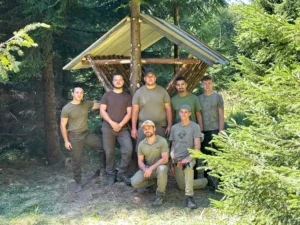We will try to give you a flavour of our adventures and what we experienced and learned there, subject to space constraints. For a start, here is a description of a typical day at camp:
Due to the processing of the day's curriculum and field observation, the "good morning" alarm was sounded outside our tents at around 5am. We then had half an hour for the breakfast procedure and then to have coffee, tea and breakfast in the dining tent (note here that the food was very tasty and, like Hungarian cuisine, heavily spiced). We rolled out of the camp in two open field vehicles while it was still dark, so that we could catch the sunrise in the field. It's winter in Botswana now, so it was about 5-8 degrees in the morning, creeping up to 20-22 degrees by afternoon. Dawn was upon us in the bush and the endless transfer of information began.
At dawn, a cavalcade of lights and smells, mixed with the sight of the land and the animals awaited us. It was incredible. Just for a taste:
We saw a pack of hunting hyenas, 80-100 pound bull elephants with tusks, leopards, lions, hyenas feasting on elephant food and all from 5-10 meters away!!!
When we told people back home about our experiences we said we were seeing the National Geographic from the inside!

A break around 9.30, tea, coffee, fruit, cake, some water, admiring the scenery, hippos or even elephants and giraffes, and then off we go. We got back to camp around 11. Then it was showers, changing clothes and the theoretical instruction. This took place in the dining tent, during the lectures we not only covered the educational topics listed in the previous article, but also talked about the life and culture of the people living here, Botswana, with our local guide and instructor, Matusi from the Bayei tribe. Lunch (usually a one course meal - lots of meat, vegetables and salad) followed. After lunch, some chatting, relaxing and the obligatory journal writing for the students, then came the practical lessons. This covered a lot of things from setting camera traps to practicing trail scanning in the field. Camera trapping is a well-known technique in this country, but in Botswana our camera traps set up around the camp (max. 100 m away) photographed hippos, hyenas, elephants, petimegas and African wildcats at night! In the late afternoon we headed back into the bush, again the animals were spotted until sunset (which was around 6.30pm here). You would think it would be evening rest, but no, after dinner (which was the main meal) campfire and lectures. Each student had to prepare a topic of their choice and give a presentation to the others, so in the evenings we could hear about Sopron, the university traditions, but also about archery and Hungarian dog breeds. Probably one of the highlights of our lives was listening to Robyn's PPT presentation on African game hunting by the crackling campfire, with the full moon slowly creeping up behind the speaker and hippos frolicking in the river next to the camp in the African night.
That was one day, not just one day, but all of them. Students' knowledge of wildlife management was expanded to a whole new chapter, and Africa was opened up to students and teachers alike.

As the days went by, beyond the first euphoric experiences, we began to understand the behaviour of the wildlife there, we began to get to know - not to be immodest - the faces of Africa. As the camp progressed, we either acquired new knowledge or completely new skills, such as tracking (in addition to species differentiation, how to estimate the age of an animal, how long it has been here, etc.). Or how the techniques we use in wildlife biology can be applied here in this area to the wildlife species living here (population estimation using synchronous counting, camera traps, technical solutions for live capture, etc.).
The theoretical and practical part of the training followed the pre-arranged curriculum, the English textbook published covered 107 pages of scientific and practical material of the camp. In addition to this, several current scientific and educational books were made available to everyone, thanks to the Foundation. In addition, all theoretical knowledge was backed up by morning and afternoon exercises and recorded in the evening exchanges.
Each of our three campsites was a little different. The first was the Khwai Community Conservation area, a forested bushland area in Mapan, interspersed with lakes and backwaters. Its wildlife was extremely abundant and our camp reminded me of something you would read about in a classic hunting book. Here, the elephants were in the limelight, shaping the habitat with their feeding and presence. There were no tall trees, but anything could emerge from the bush. With herbivores in abundance, it was no wonder that there were plenty of predators to be seen. Our second camp was at the Moremi Game Reserve. A large area of this is a distinct wetland, with swamps, bogs, very rich wildlife, mainly birdlife, less trees. In the dry season it is a picture of grassy savannah. Elephants were fewer, but other herbivores were perhaps even more abundant, if possible, and so of course were predators. The third area Nxai Pan National Park showed a different face of Africa.
Erika Csányi, Dr Ferenc Jánoska and Dr Gyula Sándor
Cover photo by Dorottya Gaál





